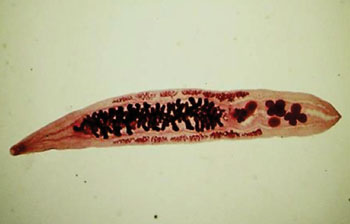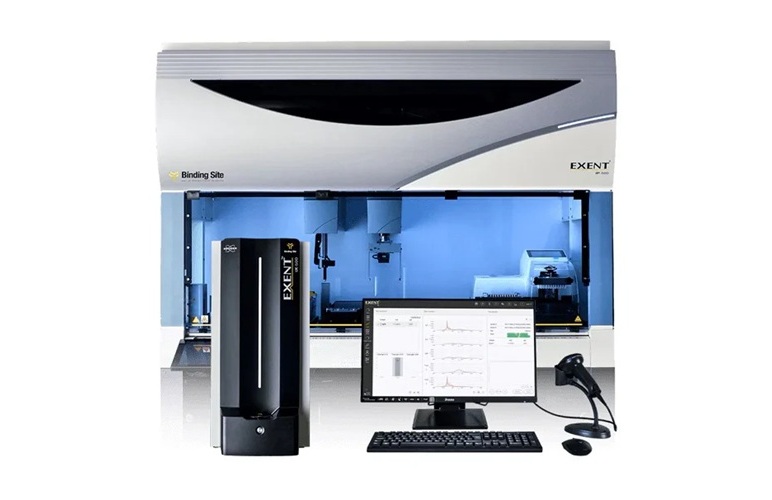Unsuspected Bacterial Link to Bile Duct Cancer Discovered
|
By LabMedica International staff writers Posted on 06 Jul 2016 |

Image: An adult Opisthorchis viverrini or Southeast Asian liver fluke stained with carmine (Photo courtesy of the CDC).
Bacteria in the bile duct have been identified as a potential risk factor in the development of bile duct cancer, or Cholangiocarcinoma, a rare but aggressive form of cancer with symptoms that do not present themselves at the early stages.
Cholangiocarcinoma (CCA) is associated with multiple risk factors that are geographically distinct; choledocal cysts and primary sclerosing cholangitis have been implicated in the development of CCA in Western populations, while infections by the liver fluke parasite have resulted in higher incidence of CCA in Southeast Asia.
An international team of scientists working with The Agency for Science, Technology and Research (Singapore) profiled 60 primary CCA tumors and matched normals, from both 28 liver fluke (Opisthorchis viverrini) associated (Ova) and 32 non-O. viverrini associated (non-OVa) cancers, using high-throughput 16S rRNA sequencing.
Agencourt AMPure XP (Beckman Coulter, Brea, CA, USA) was used to purify the amplified products and purified products were visualized using Agilent Bioanalyzer, prepared with Agilent High Sensitivity DNA Kit (Agilent Technologies, Waldbronn, Germany). As controls for assay specificity, 16S rRNA polymerase chain reaction (PCR) was performed with extraction controls and the absence of amplification products was confirmed using Agilent Bioanalyzer.
The team discovered that bile duct tissue harbored a community of diverse bacteria species. Stenotrophomonas species, previously implicated in bile duct infections, were found to be preferentially dwelling in tumor tissue compared to normal tissue of non-fluke-infected CCA patients, highlighting their potential role in development of CCA.
In comparison to non-fluke-infected CCA tissues, fluke-infected CCA tissues were found to contain enteric bacteria whose metabolic outputs, bile acids and ammonia, have been previously linked to carcinogenesis, or the formation of cancers. Taken together, the results suggest a role for bile duct tissue microbiome in development of CCA and which may accordingly be used as a target for therapy.
Niranjan Nagarajan, PhD, the co-senior author of the study, said, “Until recently, our understanding of bacterial communities resident in our body and their association with diseases has been limited. The associations detected in this study provide a smoking gun for the role of bacteria in bile duct cancer, and we hope that this discovery will accelerate our search for a cure for cholangiocarcinoma.” The study was published in the June 2016 issue of the journal EbioMedicine.
Related Links:
The Agency for Science, Technology and Research
Beckman Coulter
Agilent Technologies
Cholangiocarcinoma (CCA) is associated with multiple risk factors that are geographically distinct; choledocal cysts and primary sclerosing cholangitis have been implicated in the development of CCA in Western populations, while infections by the liver fluke parasite have resulted in higher incidence of CCA in Southeast Asia.
An international team of scientists working with The Agency for Science, Technology and Research (Singapore) profiled 60 primary CCA tumors and matched normals, from both 28 liver fluke (Opisthorchis viverrini) associated (Ova) and 32 non-O. viverrini associated (non-OVa) cancers, using high-throughput 16S rRNA sequencing.
Agencourt AMPure XP (Beckman Coulter, Brea, CA, USA) was used to purify the amplified products and purified products were visualized using Agilent Bioanalyzer, prepared with Agilent High Sensitivity DNA Kit (Agilent Technologies, Waldbronn, Germany). As controls for assay specificity, 16S rRNA polymerase chain reaction (PCR) was performed with extraction controls and the absence of amplification products was confirmed using Agilent Bioanalyzer.
The team discovered that bile duct tissue harbored a community of diverse bacteria species. Stenotrophomonas species, previously implicated in bile duct infections, were found to be preferentially dwelling in tumor tissue compared to normal tissue of non-fluke-infected CCA patients, highlighting their potential role in development of CCA.
In comparison to non-fluke-infected CCA tissues, fluke-infected CCA tissues were found to contain enteric bacteria whose metabolic outputs, bile acids and ammonia, have been previously linked to carcinogenesis, or the formation of cancers. Taken together, the results suggest a role for bile duct tissue microbiome in development of CCA and which may accordingly be used as a target for therapy.
Niranjan Nagarajan, PhD, the co-senior author of the study, said, “Until recently, our understanding of bacterial communities resident in our body and their association with diseases has been limited. The associations detected in this study provide a smoking gun for the role of bacteria in bile duct cancer, and we hope that this discovery will accelerate our search for a cure for cholangiocarcinoma.” The study was published in the June 2016 issue of the journal EbioMedicine.
Related Links:
The Agency for Science, Technology and Research
Beckman Coulter
Agilent Technologies
Latest Pathology News
- AI Tool Rapidly Analyzes Complex Cancer Images for Personalized Treatment
- Diagnostic Technology Performs Rapid Biofluid Analysis Using Single Droplet
- Novel Technology Tracks Hidden Cancer Cells Faster
- AI Tool Improves Breast Cancer Detection
- AI Tool Predicts Treatment Success in Rectal Cancer Patients
- Blood Test and Sputum Analysis Predict Acute COPD Exacerbation
- AI Tool to Transform Skin Cancer Detection with Near-Perfect Accuracy
- Unique Immune Signatures Distinguish Rare Autoimmune Condition from Multiple Sclerosis
- Simple Optical Microscopy Method Reveals Hidden Structures in Remarkable Detail
- Hydrogel-Based Technology Isolates Extracellular Vesicles for Early Disease Diagnosis
- AI Tool Improves Accuracy of Skin Cancer Detection
- Highly Sensitive Imaging Technique Detects Myelin Damage
- 3D Genome Mapping Tool to Improve Diagnosis and Treatment of Genetic Diseases
- New Molecular Analysis Tool to Improve Disease Diagnosis
- Tears Offer Noninvasive Alternative for Diagnosing Neurodegenerative Diseases
- AI-Powered Method Combines Blood Data to Accurately Measure Biological Age
Channels
Clinical Chemistry
view channel
Chemical Imaging Probe Could Track and Treat Prostate Cancer
Prostate cancer remains a leading cause of illness and death among men, with many patients eventually developing resistance to standard hormone-blocking therapies. These drugs often lose effectiveness... Read more
Mismatch Between Two Common Kidney Function Tests Indicates Serious Health Problems
Creatinine has long been the standard for measuring kidney filtration, while cystatin C — a protein produced by all human cells — has been recommended as a complementary marker because it is influenced... Read moreMolecular Diagnostics
view channel
First-Of-Its-Kind Automated System Speeds Myeloma Diagnosis
More than 176,000 people are diagnosed with multiple myeloma worldwide each year, yet the current diagnostic pathway can be slow and uncertain, often relying on a highly subjective interpretation of test results.... Read more
Blood Protein Profiles Predict Mortality Risk for Earlier Medical Intervention
Elevated levels of specific proteins in the blood can signal increased risk of mortality, according to new evidence showing that five proteins involved in cancer, inflammation, and cell regulation strongly... Read moreHematology
view channel
Platelet Activity Blood Test in Middle Age Could Identify Early Alzheimer’s Risk
Early detection of Alzheimer’s disease remains one of the biggest unmet needs in neurology, particularly because the biological changes underlying the disorder begin decades before memory symptoms appear.... Read more
Microvesicles Measurement Could Detect Vascular Injury in Sickle Cell Disease Patients
Assessing disease severity in sickle cell disease (SCD) remains challenging, especially when trying to predict hemolysis, vascular injury, and risk of complications such as vaso-occlusive crises.... Read more
ADLM’s New Coagulation Testing Guidance to Improve Care for Patients on Blood Thinners
Direct oral anticoagulants (DOACs) are one of the most common types of blood thinners. Patients take them to prevent a host of complications that could arise from blood clotting, including stroke, deep... Read moreImmunology
view channel
Gene Signature Test Predicts Response to Key Breast Cancer Treatment
DK4/6 inhibitors paired with hormone therapy have become a cornerstone treatment for advanced HR+/HER2– breast cancer, slowing tumor growth by blocking key proteins that drive cell division.... Read more
Chip Captures Cancer Cells from Blood to Help Select Right Breast Cancer Treatment
Ductal carcinoma in situ (DCIS) accounts for about a quarter of all breast cancer cases and generally carries a good prognosis. This non-invasive form of the disease may or may not become life-threatening.... Read moreMicrobiology
view channel
Rapid Assay Identifies Bloodstream Infection Pathogens Directly from Patient Samples
Bloodstream infections in sepsis progress quickly and demand rapid, precise diagnosis. Current blood-culture methods often take one to five days to identify the pathogen, leaving clinicians to treat blindly... Read more
Blood-Based Molecular Signatures to Enable Rapid EPTB Diagnosis
Extrapulmonary tuberculosis (EPTB) remains difficult to diagnose and treat because it spreads beyond the lungs and lacks easily accessible biomarkers. Despite TB infecting 10 million people yearly, the... Read more
15-Minute Blood Test Diagnoses Life-Threatening Infections in Children
Distinguishing minor childhood illnesses from potentially life-threatening infections such as sepsis or meningitis remains a major challenge in emergency care. Traditional tests can take hours, leaving... Read more
High-Throughput Enteric Panels Detect Multiple GI Bacterial Infections from Single Stool Swab Sample
Gastrointestinal (GI) infections are among the most common causes of illness worldwide, leading to over 1.7 million deaths annually and placing a heavy burden on healthcare systems. Conventional diagnostic... Read moreTechnology
view channel
AI Saliva Sensor Enables Early Detection of Head and Neck Cancer
Early detection of head and neck cancer remains difficult because the disease produces few or no symptoms in its earliest stages, and lesions often lie deep within the head or neck, where biopsy or endoscopy... Read more
AI-Powered Biosensor Technology to Enable Breath Test for Lung Cancer Detection
Detecting lung cancer early remains one of the biggest challenges in oncology, largely because current tools are invasive, expensive, or unable to identify the disease in its earliest phases.... Read moreIndustry
view channel
Abbott Acquires Cancer-Screening Company Exact Sciences
Abbott (Abbott Park, IL, USA) has entered into a definitive agreement to acquire Exact Sciences (Madison, WI, USA), enabling it to enter and lead in fast-growing cancer diagnostics segments.... Read more






















